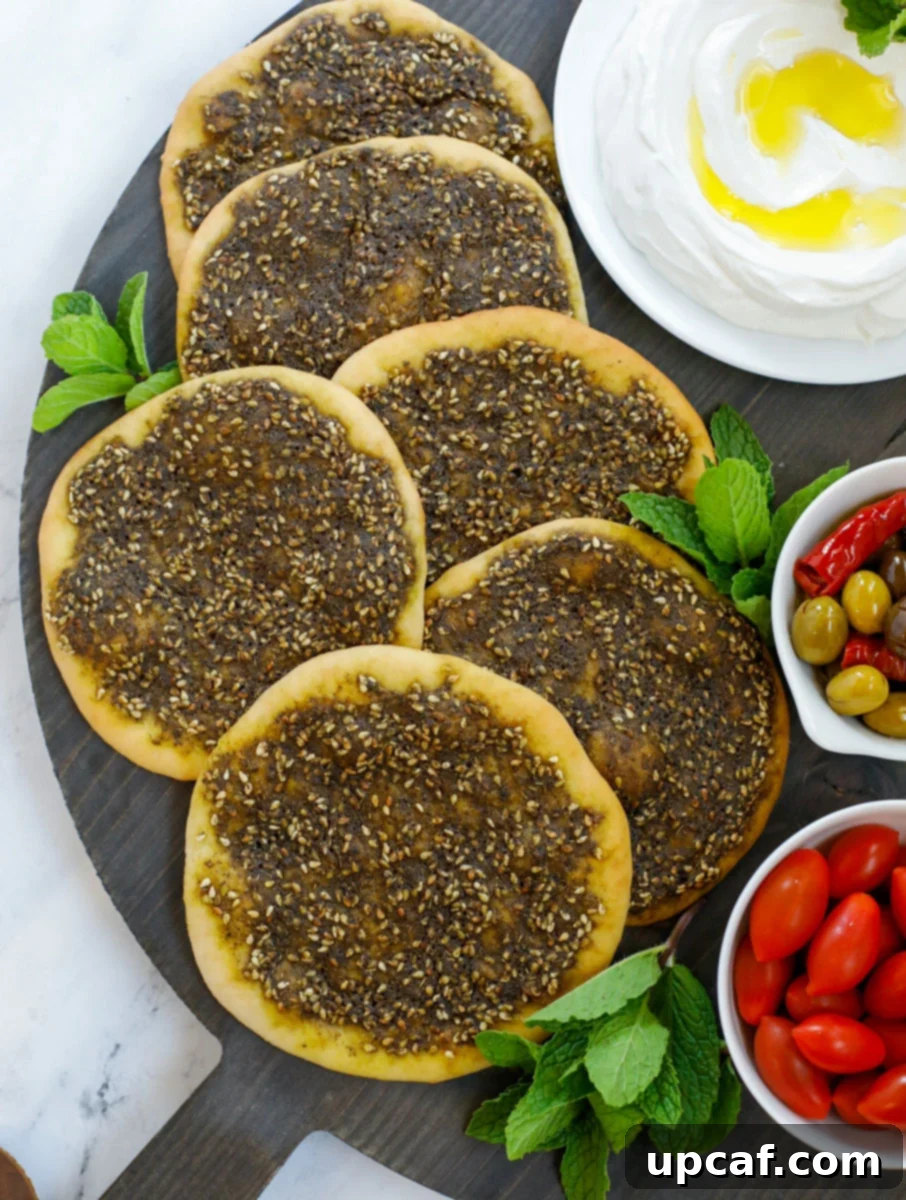Welcome to the enchanting world of Za’atar Manakeesh, a culinary cornerstone of Lebanese and wider Levantine breakfast tables. More than just a meal, Manakeesh Za’atar (also known as manaeesh, mana’ish, or manaqish) embodies tradition, comfort, and the vibrant flavors of the Middle East. Imagine a beautifully baked, fluffy flatbread, artfully adorned with a pungent, aromatic za’atar spice blend mixed with rich olive oil. It’s a sensory experience that awakens the palate and nourishes the soul, making it a beloved staple for families across the region and beyond.
This savory flatbread is not merely a local delicacy; it’s a phenomenon found in almost every bakery and home across the Levantine countries, including Lebanon, Syria, Palestine, and Jordan. From bustling city bakeries to quaint village ovens, Manakeesh holds a place of honor, especially during breakfast hours. Its versatility extends beyond a simple morning meal, often enjoyed as a snack, light lunch, or even an appetizer, proving that there’s no wrong time to indulge in its delightful taste.

While Za’atar Manakeesh reigns supreme, the world of Manakeesh offers a spectrum of flavors. Many bakeries offer innovative variations, such as the popular “cocktail” Manakeesh, which features a harmonious blend of creamy Akawi cheese and the earthy za’atar topping. This delightful combination offers a fantastic balance of salty, tangy, and herbal notes. Growing up, my mornings were often brightened by the presence of Manakeesh of all kinds. Yet, the Za’atar version, paired surprisingly with a can of Pepsi, held a special place in my school-day memories – a truly iconic duo! While I still occasionally enjoy that nostalgic pairing when on the go, at home, I cherish serving this warm, fragrant flatbread with a comforting cup of hot tea and a dollop of tangy Labneh spread. It’s a simple pleasure that never gets old.
Why You’ll Love This Authentic Za’atar Manakeesh Recipe
Embarking on the journey to make homemade Za’atar Manakeesh might seem daunting at first, but this recipe is meticulously crafted to be approachable and incredibly rewarding. Here’s why this particular Za’atar Manakeesh recipe will quickly become a cherished favorite in your kitchen:
- Effortlessly Simple: Forget complicated baking techniques or lengthy proofing times. This recipe streamlines the process, focusing on a straightforward dough preparation and a simple za’atar application. You won’t need to fret over yeast activation or complex folding methods, making it ideal for both novice bakers and seasoned pros seeking an easy, authentic dish.
- Superior Make-Ahead Potential & Storage: One of the greatest advantages of this recipe is its excellent keeping quality. Prepared Manakeesh can be stored in the refrigerator for up to 10 days, maintaining its freshness and flavor. Even better, it freezes beautifully for several months, allowing you to prepare large batches and enjoy spontaneous Middle Eastern breakfasts or snacks whenever the craving strikes.
- Minimal, Wholesome Ingredients: Beyond the fundamental pantry staples required for the dough – flour, instant yeast, oil, milk, sugar, and yogurt – the star of the show is simply the za’atar spice blend. This means you’re working with natural, easily accessible components, ensuring a wholesome and delicious end product.
- Authentic Lebanese Flavor Profile: This recipe captures the true essence of traditional Lebanese Za’atar Manakeesh. Every bite offers a perfect balance of the fluffy, slightly chewy flatbread and the earthy, tangy, and fragrant za’atar topping, transporting your taste buds straight to the heart of the Levant.
- Versatile for Any Meal: While traditionally a breakfast food, Za’atar Manakeesh is incredibly versatile. It makes for an excellent appetizer, a light lunch with a side salad, or a satisfying snack. Its adaptability means you can enjoy this delightful flatbread at any time of day.
Unveiling Za’atar: The Quintessential Middle Eastern Spice Blend
At the very heart of Za’atar Manakeesh lies its namesake, Za’atar – a distinctive and revered Middle Eastern spice blend. This aromatic mixture is far more than just a seasoning; it’s a cultural icon, deeply embedded in the culinary traditions of the Levant. The traditional composition typically includes dried wild thyme, savory sumac (which imparts a delightful lemony tang), toasted sesame seeds (adding a nutty depth), and a touch of salt. However, regional variations exist, with some blends incorporating marjoram, oregano, or other herbs, each offering a subtle twist on the classic profile.
For those who grew up with authentic za’atar, the quality of the blend is paramount. Many, like myself, prefer homemade or artisanal blends over mass-produced store versions, as the latter often lack the freshness and complexity of flavor. I’m fortunate that my mother-in-law consistently prepares a fresh batch for us during our visits to Lebanon, ensuring we always have a genuine supply. For those without a direct connection to homemade za’atar, seeking out high-quality, ethically sourced blends is crucial. Recently, I’ve discovered two exceptional sources that deliver authentic Lebanese za’atar straight to your door: Albustan Foods and Terranean Herbs and Spices. Both offer blends that truly capture the essence of this magnificent spice.

What Exactly is Manakeesh? A Journey Through Levantine Flatbreads
Manakeesh, in its essence, is a versatile and delectable Levantine flatbread that serves as a canvas for an array of mouth-watering toppings. It’s an indispensable part of Middle Eastern cuisine, evolving from a simple bread into a rich tapestry of flavors and textures. While the Za’atar variety is arguably the most famous and beloved, the world of Manakeesh offers an exciting culinary adventure through its diverse permutations. My personal favorites, which I could happily devour at any time of day, include:
- Za’atar Manakeesh: The classic, with its vibrant green herb and olive oil topping.
- Akawi Cheese Manakeesh: Featuring a generous layer of salty, mild Akawi cheese that bakes into a gooey, savory delight.
- Meat Manakeesh (Lahm bi Ajeen): Topped with a savory mixture of minced lamb or beef, often seasoned with tomatoes, onions, and spices.
- Cocktail Manakeesh: A fantastic hybrid combining the best of both worlds with a blend of Za’atar and Akawi cheese.
- Keshek Manakeesh: A unique topping made from fermented dried yogurt and often mixed with finely chopped tomatoes and onions, offering a distinctive tangy flavor.
- Tomato and Onion Manakeesh: A fresh and zesty option, perfect for those who enjoy a lighter, more vegetable-forward flatbread.
While Manakeesh is often categorized as a breakfast food, its appeal transcends morning hours. People throughout the Levant enjoy it for lunch, dinner, or as a satisfying snack. There are truly no rules when it comes to savoring this delightful flatbread.
For this homemade Za’atar Manakeesh recipe, we’ll be using a simple yet robust pizza dough recipe, which I’ve found to be incredibly adaptable for various baked goods. While traditionally, the very best Manakeesh is baked in a scorching wood-fired brick oven, delivering an unparalleled smoky flavor and crispy crust, a conventional home oven yields wonderfully delicious results that are still far superior to any store-bought alternative. Unless you happen to have a traditional brick oven in your backyard, your standard kitchen oven will do a magnificent job of producing soft, fluffy, and flavorful Manakeesh.
Crafting Homemade Za’atar Manakeesh: A Step-by-Step Guide
Creating your own Za’atar Manakeesh from scratch is a deeply satisfying process, yielding warm, aromatic flatbreads that are infinitely better than anything you can buy. Follow these detailed steps to bring the authentic taste of the Levant into your home kitchen.
Gather Your Essentials: What You’ll Need
Before you begin, ensure you have all the necessary ingredients and equipment:
- For the Dough: Our simple, homemade Manakeesh dough (details below).
- For the Topping: High-quality Za’atar blend and good extra virgin olive oil.
- Equipment: A sturdy rolling pin, mixing bowls, an electric stand mixer with a dough hook (optional but recommended), a baking sheet, and parchment paper or a non-stick baking mat.
Mastering the Homemade Manakeesh Dough
The foundation of exceptional Manakeesh is a perfectly prepared dough. This recipe delivers a soft, pliable, and flavorful dough that’s a joy to work with.
Dough Ingredients:
- 3 cups All-purpose flour, sifted
- 1½ tbsp. granulated sugar
- ¼ tsp. fine sea salt
- 2 tbsps. instant yeast
- ¾ tbsp. baking powder
- 3 tbsps. canola or vegetable oil
- ½ cup whole fat yogurt
- 1 cup whole milk, lukewarm
- Oil spray (for the bowl)
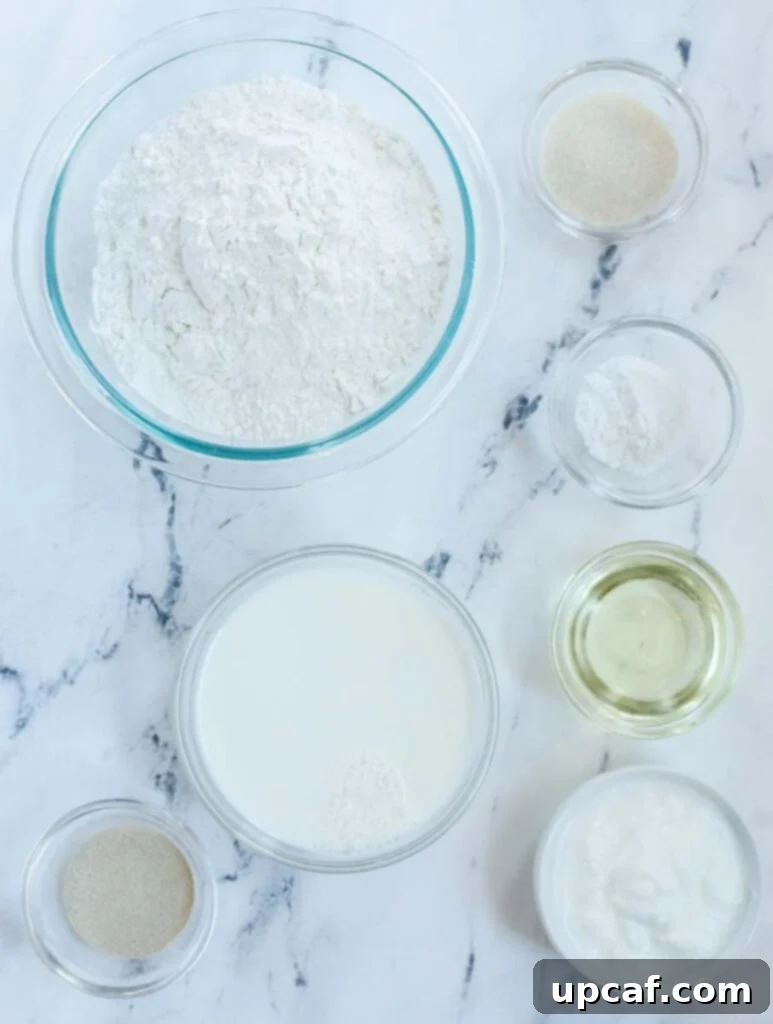
Step-by-Step Dough Preparation:
- Mixing the Ingredients: In a large mixing bowl, combine all the dry ingredients: sifted flour, sugar, salt, instant yeast, and baking powder. Whisk them together thoroughly to ensure even distribution. In a separate bowl, whisk together the wet ingredients: canola or vegetable oil, whole fat yogurt, and lukewarm whole milk. Gradually add the wet mixture to the dry ingredients. Using an electric stand mixer fitted with a dough hook, mix on low speed for 3-4 minutes until the ingredients are well combined and a shaggy dough forms. If mixing by hand, combine thoroughly with a spoon and then proceed to kneading.
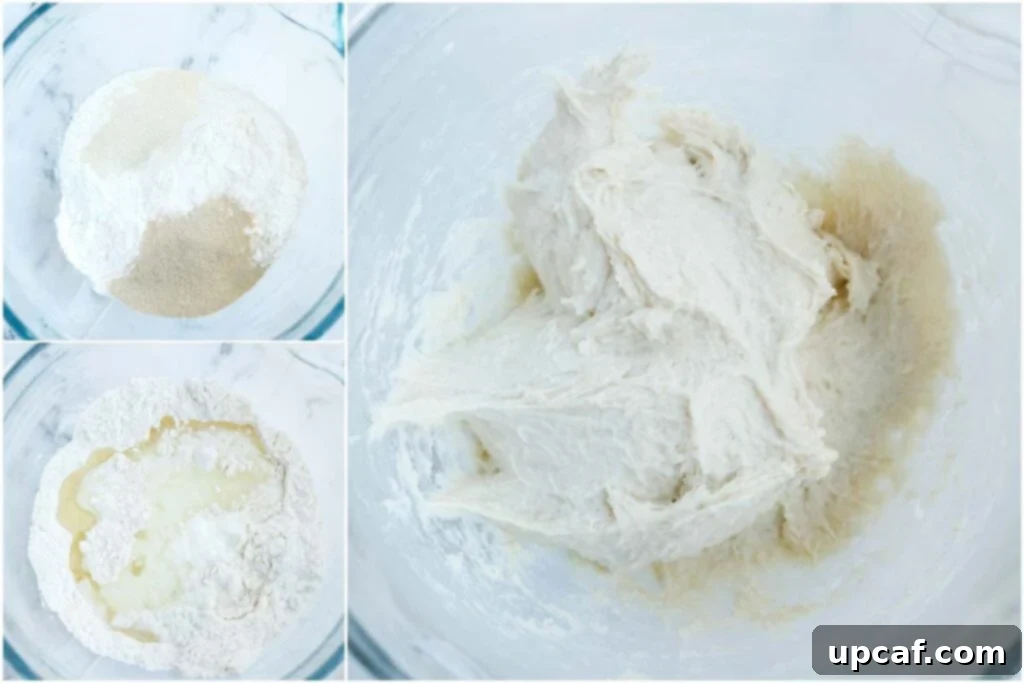
- Kneading for Smoothness: Lightly dust a clean cutting board or work surface with flour. Transfer the dough from the mixer bowl onto the floured surface. Knead the dough by hand for approximately one minute until it becomes smooth and elastic. Form the dough into a neat ball. Lightly spray your mixing bowl with oil to prevent sticking, then return the dough ball to the bowl.
- The First Rise: Cover the bowl tightly with plastic wrap or a clean kitchen towel. Allow the dough to rest and rise in a warm, draft-free place for about 1 hour, or until it has doubled significantly in size. This crucial step develops flavor and ensures a light, airy texture.

- Portioning the Dough: Once the dough has risen, gently punch it down to release the accumulated air. Transfer the dough back to your lightly floured cutting board. Knead it briefly to reshape it into a smooth ball. Now, divide the dough into 8 equal parts. For smaller, more traditional Manakeesh, further divide each of these 8 parts into 2 portions, resulting in 16 smaller, manageable dough balls. You can adjust the size of your Manakeesh according to your preference; simply cut into more or fewer pieces.
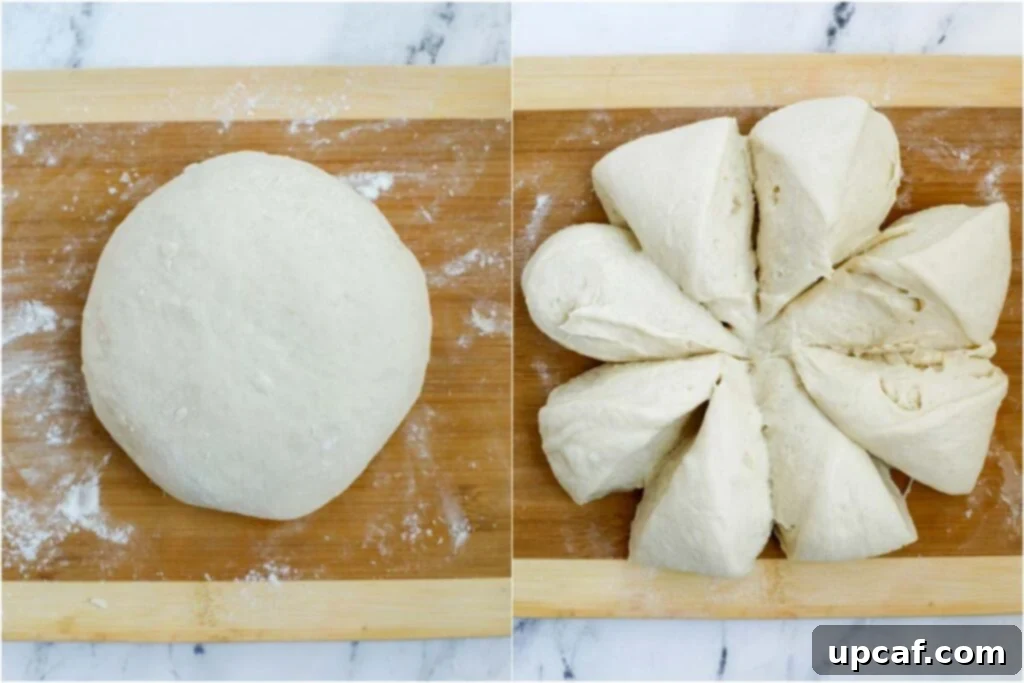
- The Final Short Rise: Roll each of the smaller dough portions into neat balls. Arrange these dough balls on a sheet pan, leaving some space between them. Cover the sheet pan with a clean kitchen towel or plastic wrap. Allow them to rest for a final 10 minutes. This short rest allows the dough to relax, making it easier to roll out and contributing to the Manakeesh’s signature fluffy texture.
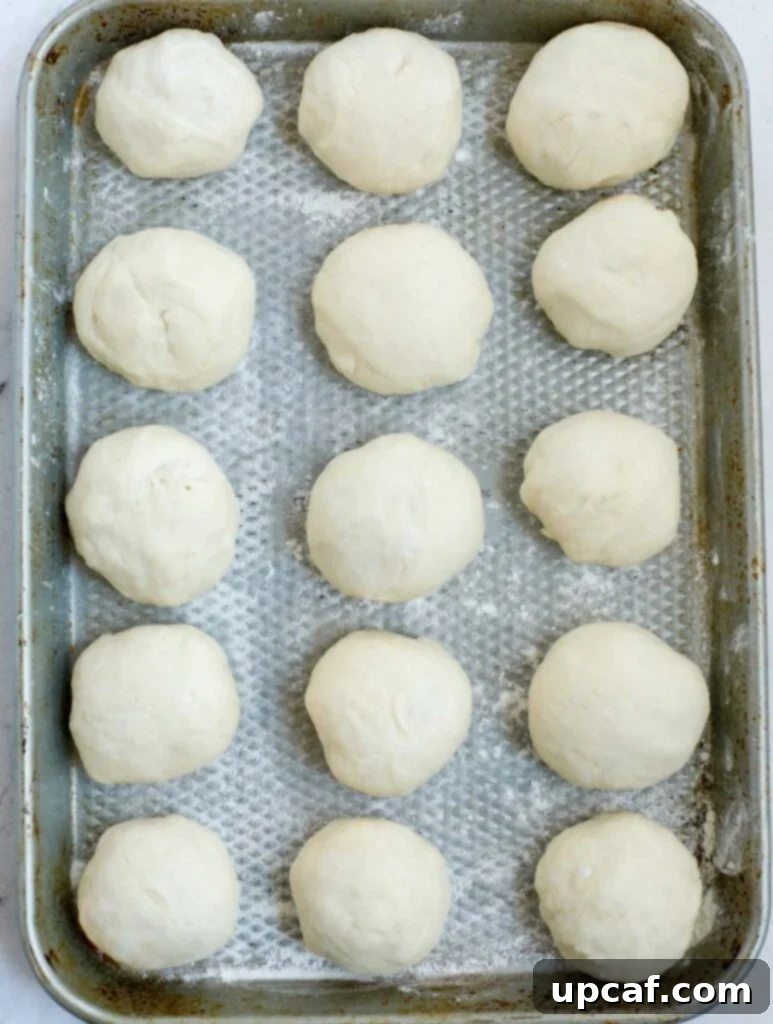
Assembling and Baking Your Flavorful Manakeesh
With your dough perfectly prepared, it’s time for the final steps that transform simple ingredients into delicious Manakeesh.
- Preheat Your Oven: Preheat your oven to a robust 425°F (220°C). A hot oven is key to achieving a beautifully puffed and quickly baked flatbread.
- Prepare the Za’atar Spread: In a small bowl, combine 1¼ cups of dry za’atar blend with ¾ cup of good quality olive oil. Mix thoroughly until you achieve a thick, spreadable consistency. Adjust the amount of olive oil as needed to reach your desired texture – it should be easily spreadable but not overly runny.
- Roll Out the Dough: Lightly dust your work surface with a touch of flour. Take one dough ball and, using a rolling pin, gently roll it out into a round flatbread, approximately 4-5 inches (10-12 cm) in diameter. The shape doesn’t need to be perfectly round; rustic charm is part of Manakeesh’s appeal. Crucially, avoid rolling the dough too thin, as this can cause it to lose its desired fluffiness. Place the rolled-out dough onto a baking sheet lined with parchment paper or a non-stick baking mat. Repeat with the remaining dough balls.
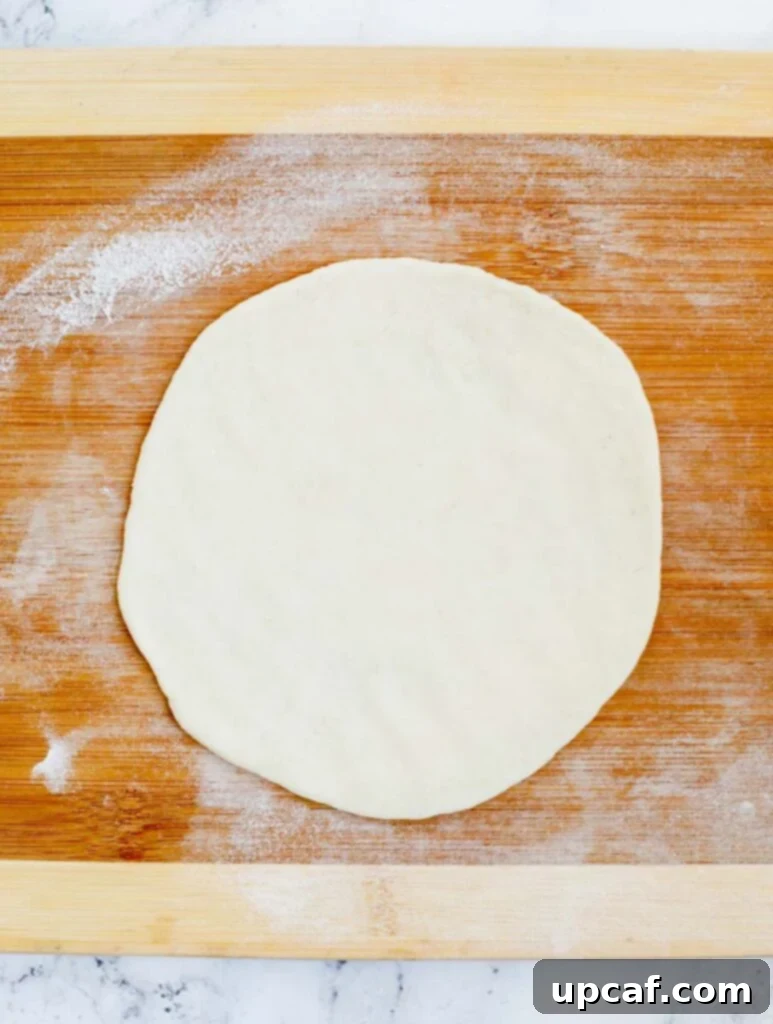
- Top with Za’atar: Spoon about 1 to 1½ tablespoons of the prepared za’atar mixture onto the center of each rolled dough disc. Using the back of the spoon or your fingers, gently spread the za’atar mixture evenly across the surface, leaving a small border around the edges.
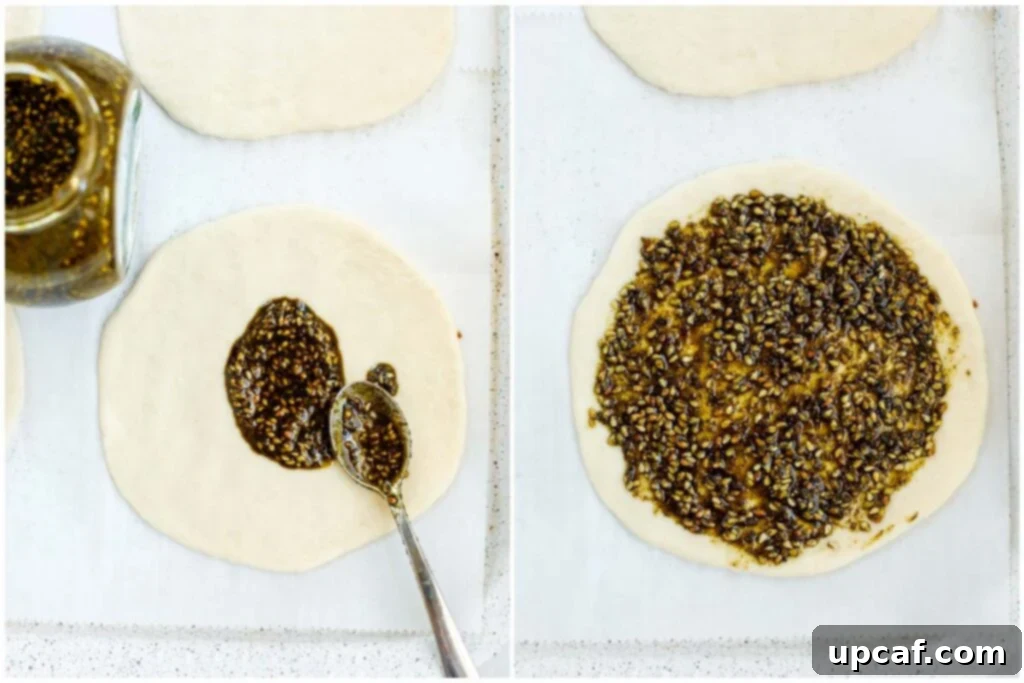
- Bake to Perfection: Transfer the baking sheet to the preheated oven. Bake for 12-15 minutes on the middle rack. Keep a close eye on them; you’re looking for the outer edges to turn a beautiful, light golden-brown. It’s essential not to overbake the Manakeesh, as this will result in a dry, crunchy texture rather than the desired soft and fluffy flatbread.
- Cool and Serve: Once baked, remove the Manakeesh from the oven and let them cool for a minute or two on the baking sheet before transferring them to a wire rack. Serve warm and enjoy!

Expert Tips for Your Best Manakeesh
Achieving perfect Za’atar Manakeesh every time is simple with these helpful tips:
- Freezing for Future Enjoyment: If you plan to freeze a batch for later, undercook the Manakeesh by about 2-3 minutes during the initial bake. This ensures they don’t become dry when reheated. When ready to enjoy, simply thaw them to room temperature and bake in a preheated 350°F (175°C) oven for 10 minutes, or until warmed through and lightly golden.
- Achieving the Ideal Texture: The key to delectable Manakeesh is a soft, fluffy texture. Avoid overbaking at all costs, as this will result in a crisp, dry flatbread rather than the desired tender bite. Watch for those lightly golden edges, and remove them promptly from the oven.
- Optimal Storage for Freshness: To keep your Manakeesh fresh for as long as possible, store cooled flatbreads in a high-quality zip-lock bag or an airtight container. This method will preserve their softness and flavor for up to 10 days in the refrigerator.
- Dough Consistency is Key: The dough should be soft, slightly tacky but not sticky, and easy to handle. If it feels too dry, add a tiny bit more lukewarm milk; if too wet, a sprinkle of flour. Proper dough consistency is crucial for a fluffy end product.
- Za’atar-to-Oil Ratio: The consistency of your za’atar spread is important. It should be thick enough to stay on the flatbread but spreadable without tearing the dough. Adjust olive oil as needed, adding a little more if it’s too dry, or a tiny bit more za’atar if it’s too liquid.
Elevating Your Meal: What to Serve with Za’atar Manakeesh
Za’atar Manakeesh is a culinary experience in itself, but it truly shines when accompanied by traditional Levantine complements. The classic spread typically includes a creamy, tangy Labneh (strained yogurt), which provides a refreshing contrast to the za’atar’s intensity. Alongside, a vibrant array of fresh vegetables like crisp cucumbers, juicy tomatoes, and peppery mint leaves adds a burst of freshness and texture. A medley of briny olives and perhaps some additional slices of cheese further enhance the experience. Imagine this delightful spread on one plate – a harmonious blend of flavors and textures that is truly irresistible! And yes, as I’ve mentioned, that nostalgic pairing of Za’atar Manakeesh with a chilled Pepsi is still a guilty pleasure for some, a testament to its versatile appeal. But for a more traditional and soothing experience, a warm cup of freshly brewed black tea is the perfect companion, tying all the flavors together in a comforting embrace.

Frequently Asked Questions About Za’atar Manakeesh
Absolutely! Freezing Manakeesh is a fantastic way to enjoy them anytime. Allow your freshly baked Manakeesh to cool completely. Then, place them in a freezer-safe zip-lock bag or an airtight container, ensuring they are well-sealed to prevent freezer burn. They maintain their best quality for 1-2 months in the freezer. To reheat, simply remove them from the freezer, let them thaw at room temperature for a short while, then bake in a preheated 350°F (175°C) oven for 5-7 minutes. If you’re really pressed for time, a quick 30-second blast in the microwave will also warm them up.
Manakeesh proudly traces its origins to the historical Levantine region of the Middle East. This vibrant culinary area encompasses present-day Lebanon, Syria, Palestine, and Jordan, and its influence extends to countries like Egypt. It has been a beloved staple in these cultures for centuries, evolving into the diverse and cherished flatbreads we enjoy today.
Yes, this Za’atar Manakeesh recipe is indeed vegetarian. It primarily consists of a simple dough topped with a za’atar spice blend and olive oil, with no meat or animal products (other than dairy in the dough, which is lacto-vegetarian) involved. It’s a fantastic plant-based option for breakfast or any meal.
In Lebanon, the term “Man’oushe” (pronounced man-oo-sheh) is frequently used to refer to a single Manakeesh flatbread. So, if you order a “Man’oushe Za’atar,” you’re asking for one individual Za’atar flatbread. “Manakeesh” is the plural form, referring to multiple flatbreads.
While homemade dough offers the best texture and flavor, you can certainly use good quality store-bought pizza dough as a convenient shortcut. Just be sure to let it come to room temperature and follow the rolling and baking instructions as outlined in the recipe for best results. Adjust baking times as necessary, as store-bought doughs can vary.
Beyond Za’atar, the world of Manakeesh toppings is incredibly diverse! Popular choices include Akawi cheese (a mild, salty cheese), Keshek (a fermented dried yogurt mixture), minced meat (Lahm bi Ajeen), and a mix of fresh vegetables like spinach or a tomato and onion blend. Each topping offers a unique taste experience, making Manakeesh a versatile delight.
Discover More Lebanese Delights
If you’ve fallen in love with the flavors of Za’atar Manakeesh, I invite you to explore more traditional Lebanese recipes:
- Lebanese Spinach Pies (Fatayer Sabanekh): Delicious savory pastries filled with a tangy spinach mixture.
- Lebanese Rice Pudding (Riz bi Haleeb): A creamy, fragrant dessert, often flavored with rosewater or orange blossom water.
- Lebanese Nights Dessert (Layali Lubnan): A light, semolina-based pudding topped with clotted cream, pistachios, and syrup.
- Maamoul Date Cookies: Traditional shortbread cookies, typically filled with dates or nuts, especially popular during holidays.
I genuinely hope you enjoy this authentic Za’atar Manakeesh recipe as much as I do. It’s more than just food; it’s a taste of heritage and a connection to rich culinary traditions. Please give it a try, savor every bite, and consider leaving a star rating and comment below. Your feedback means the world! Share your delicious recreations with me on INSTAGRAM using my hashtag. For all my latest social posts, recipes, and culinary adventures, make sure to follow Cookin’ With Mima on FACEBOOK | INSTAGRAM | PINTEREST.
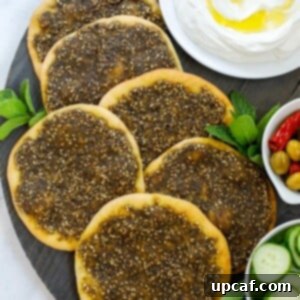
Manakeesh Za’atar
Equipment
- Rolling pin
- Mixing bowls
- Electric stand mixer (optional)
- Baking sheet
- Parchment paper or baking mat
Ingredients
- 1¼ cup Za’atar, dry blend
- ¾ cup olive oil, adjust for desired consistency
- Flour for dusting and rolling
For the Dough
- 3 cup All-purpose flour, sifted
- 1½ tbsp. granulated sugar
- ¼ tsp. salt
- 2 tbsps. instant yeast
- ¾ tbsp. baking powder
- 3 tbsps. canola or vegetable oil
- ½ cup whole fat yogurt
- 1 cup whole milk, lukewarm
- Oil spray for bowl
Instructions
The Dough
- In a large mixing bowl, combine sifted all-purpose flour, sugar, salt, instant yeast, and baking powder. Whisk well. In a separate bowl, whisk together canola or vegetable oil, whole fat yogurt, and lukewarm whole milk. Gradually add the wet ingredients to the dry, mixing with an electric stand mixer (using a dough hook) on low speed for 2-4 minutes until well combined. If mixing by hand, stir until a shaggy dough forms.
- Transfer the dough from the bowl to a lightly floured cutting board. Knead the dough gently by hand for approximately 1 minute until it becomes smooth and forms a nice ball shape. Lightly spray the mixing bowl with oil spray, then return the dough ball to the bowl. Cover the bowl and allow the dough to rest and rise in a warm place for 1 hour.
- Once the dough has doubled in size, gently punch it down to release the air. Remove the dough from the bowl again and transfer it back to the cutting board. Sprinkle with a little flour and knead briefly to reshape it into a smooth ball.
- Divide the dough evenly into 16 individual pieces. A helpful method is to first cut the round dough into 8 triangles, then further divide each triangle into two portions. Adjust the size of the pieces according to your preference for bigger or smaller Manakeesh.
- Form each dough portion into a small ball and place them on a sheet pan. Cover with a kitchen towel or plastic wrap and let them rest for an additional 10 minutes for a final, short rise.
Assembly and Baking
- Preheat your oven to 425°F (220°C).
- In a small bowl, mix the za’atar with the olive oil until you achieve a spreadable consistency. Add more olive oil if needed.
- Lightly dust your cutting board with flour. Roll out one piece of dough into a round flatbread, approximately 4 inches wide. It doesn’t need to be perfectly shaped, but ensure it’s not too thin to retain its fluffiness. Place onto a lined baking sheet or non-stick baking pan. Repeat this step for the remaining dough pieces.
- Evenly spread 1 to 1½ tablespoons of the za’atar mixture onto each rolled dough disc, leaving a small border around the edge.
- Bake on the middle rack of your preheated oven for 12-15 minutes, or until the edges are lightly golden brown. Be careful not to overcook, as this will make them crispy instead of soft and fluffy.
- Allow to cool for a minute or two on the baking sheet, then transfer to a wire rack. Enjoy warm with Labneh spread, olives, and a cup of tea.
Notes
To freeze, bake a batch, allow them to cool completely, then store in a good quality freezer bag. When ready to enjoy, simply thaw to room temperature and reheat in a preheated 350°F (175°C) oven for 5-7 minutes.
Nutrition
Carbohydrates: 31g |
Protein: 5g |
Fat: 15g |
Saturated Fat: 5g |
Cholesterol: 3mg |
Sodium: 125mg |
Potassium: 217mg |
Fiber: 8g |
Sugar: 3g |
Vitamin A: 735IU |
Vitamin C: 9mg |
Calcium: 420mg |
Iron: 24mg
Like this recipe? Rate and comment below!
